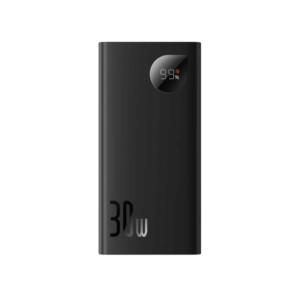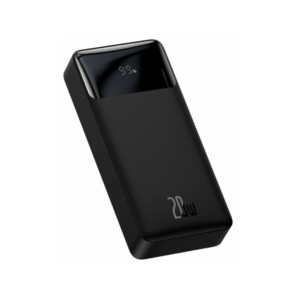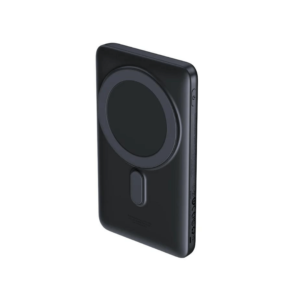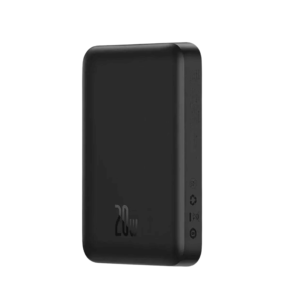Let us be honest, if you live in Nigeria, you already know that expecting steady electricity is like expecting danfo drivers to give you your balance without stress. Light can go off at any time, and when it does, your phone, laptop, or tablet still needs to be on. Whether you are a student trying to join an online class, a business person rushing for a Zoom meeting, or just someone trying to scroll Instagram in traffic, staying charged is not a luxury; it is a survival need.
That is why power banks have turned into one of the most important gadgets around. If you forget your power bank at home, it can pain you more than forgetting your lunch. But once you enter a shop or start browsing online, you see numbers everywhere — 10,000mAh, 20,000mAh, 65W output, Quick Charge, Power Delivery, efficiency percentage, like you are about to sit for WAEC physics exam.
One of the most common questions people ask us at Techmall Nigeria is:
Does the power bank capacity, that mAh number, really affect how fast it charges my phone?
The answer is yes, but it is not that straightforward. Capacity is how much power the bank can hold, while output affects how fast it pushes that power to your device. Both matter. That is why we created this guide, to help break everything down in plain English, with zero confusion. After reading this, you will know exactly how to choose a power bank that matches your lifestyle, your devices, and Nigeria’s wahala power supply.
Understanding Power Bank Capacity (mAh)
First, let us explain this famous tech term — mAh, which stands for milliampere-hour. That is the number you see everywhere when buying a power bank. It tells you how much power the device can store. In simple terms, it is like measuring the size of a bucket. A 10,000mAh power bank is a small bucket. A 20,000mAh is a bigger bucket. A 30,000mAh? Omo, that one is like those yellow jerrycans they use to fetch water from a far borehole — it carries plenty.
Now, what does this mean for you in real life?
-
A 10,000mAh power bank can charge an average smartphone about 1.5 to 2 times
-
A 20,000mAh power bank can give you about 3 to 4 full charges
-
A 30,000mAh one? You can charge your phone 5 times or more, especially if you use mid-range devices
But let us spill some truth, it is not just about the number of charges. The capacity also affects efficiency. Just because the mAh is high does not always mean faster charging. How well the power is transferred depends on:
-
The internal wiring and circuit quality
-
The battery cells inside the power bank
-
The phone you are trying to charge (some phones drink power like chilled Coke on a sunny day)
So yes, bigger is better for lasting power, but charging speed and performance also depend on what is going on inside the power bank, not just the size.
Bigger Capacity Does Not Always Mean Faster Charging
Many people in Nigeria believe that if a power bank has 30,000mAh, it will charge their phone faster than a 10,000mAh one. But that is not always true. While a bigger capacity means the power bank can charge your device more times, charging speed is a completely different issue.
Here are the real things that control charging speed:
-
Output wattage (W) of the power bank
-
Amperage (A) and voltage (V) matching your phone
-
Fast charging support, such as Power Delivery (PD), Quick Charge (QC), or VOOC
-
Cable quality — a cheap or damaged cable will slow things down
-
Your phone’s charging capability — some phones cannot even take fast charge, no matter what you do
So yes, a 30,000mAh power bank might look powerful, but if it only delivers 5W of power and does not support fast charging, it can still charge slower than a smaller 10,000mAh power bank that supports 22.5W or 33W fast charging.
🔥 Techmall Tip:
When you are buying a power bank, do not just focus on the big mAh number. Always check the output wattage. Look for power banks with 18W, 22.5W, 33W, or 45W output. These are much faster. You will find this information on the product box or in the product description online. Make sure you read before you buy.
How Capacity Affects Efficiency and Energy Loss
Let us be honest, no power bank on this earth is 100 percent efficient. That means when you buy a 20,000mAh power bank, you should not expect it to deliver the full 20,000mAh to your phone. Why? Because some energy always gets lost along the way.
Think of it like NEPA supplying light to your area—by the time it passes through all the transformers, cables, and poles, what reaches your house is not always full current. The same thing happens inside a power bank. Energy is lost during:
-
Voltage conversion
-
Heat generation
-
Circuit performance
Here is what you can really expect:
-
Most power banks give about 85% to 90% actual energy
-
So your 20,000mAh power bank may only give you around 17,000mAh in real usage
-
If the power bank is poor quality, the efficiency can drop to 75% or less
So why does capacity still matter?
- Extra capacity helps absorb energy loss
A bigger battery gives you more room to lose energy without it affecting the performance too much. Even after losing 10–15%, you still have enough juice left to charge your phone multiple times. -
High-capacity power banks usually have better battery cells
This means more stable power delivery, better heat control, and less drama when charging. -
You can charge more things at once
These days, it is not just your phone you need to charge. You might also be charging wireless earphones, a smartwatch, or even a small fan. A high-capacity power bank can handle all of that without complaining like a keke trying to climb Third Mainland Bridge.
🔥 Techmall Tip:
If you often charge more than one device or use power banks during long travels or power outages, aim for something above 20,000mAh with at least 85% efficiency. You will thank yourself later.
Fast Charging vs. High Capacity: Which One Should Matter More?
This one boils down to how you live your life day to day, especially with our unpredictable power situation in Nigeria. Do you stay hours without light? Do you need your phone charged quickly between meetings or lectures? Your answer will guide your choice.
Go for high capacity if:
-
You regularly face long hours of blackout or unreliable power.
-
You use multiple devices every day—phone, earbuds, smartwatches, etc.
-
You travel often or live in an area where even gen or solar can be unreliable.
Go for fast charging if:
-
You are always on the move and need quick top-ups, maybe during your lunch break or while waiting in traffic.
-
Your phone supports Quick Charge 3.0, Power Delivery (PD), or VOOC charging.
-
You live in a city where NEPA brings light in short bursts, you want to take full advantage of that brief power window.
🔥 Techmall Tip:
Why choose one when you can enjoy both? Look for a power bank with solid capacity (like 20,000mAh or more) and fast charging support (18W, 22.5W, or higher). A great example is the Havit 30000mAh Power Bank – PB55 —plenty of juice, and it charges like a boss.
How Power Banks Handle Different Devices
One question we hear often at Techmall is, “Can one power bank charge my phone, tablet, and smartwatch all at the same time—and at the same speed?” Well, the short answer is: not really.
Different gadgets need different amounts of power to charge properly. Your phone, your tablet, and your Bluetooth earpiece all speak different “charging languages,” so to speak.
Here is how it usually works:
-
Phones often charge at 5V/2A if they are using standard charging. If your phone supports fast charging, it may pull even more.
-
Tablets are power-hungry and can ask for 9V/2.5A or higher. If your power bank cannot keep up, the charging will crawl.
-
Smartwatches or TWS earbuds are delicate. They need low-voltage, low-current charging to avoid overheating or damage.
Now this is where multi-port power banks shine. A good one will have:
-
One USB-A port that supports 22.5W Quick Charge
-
One USB-C port with 18W Power Delivery
-
Maybe even a micro-USB input for recharging the bank itself
With these options, you can charge your phone, your tablet, and your earbuds at the same time, without frying anything or slowing things down unnecessarily. No more choosing which gadget to prioritise—everything gets power, and everything stays safe.
🔥 Techmall Tip:
Always check the label on your power bank. If it has multiple output ratings and supports fast charging protocols, you are in good hands. A solid choice is the Anker PowerCore or Oraimo PowerBox series, depending on your budget.
How Long Will It Take to Charge the Power Bank Itself?
Now, this is one part a lot of people forget to check. It is not just about how fast your power bank charges your phone, you also need to know how long it will take to fill up that power bank itself.
The truth is, the bigger the battery, the longer the wait. A 30,000mAh power bank can feel like fetching water into a drum with a cup. If you use a slow charger or cable, you might be staring at 10 hours or more before it gets full.
Here is what affects the charging time:
-
Input wattage: This is how much power the power bank accepts. Some support only 10W, while others allow up to 18W, 22.5W, or more.
-
Your wall charger: Are you using that small charger that came with your old phone? You may grow older waiting.
-
Cable type: USB-C is always better than micro-USB. It is faster and more efficient.
🔥 Techmall Tip:
If NEPA gives you only two hours of light at night, you cannot afford slow charging. Look for a power bank that supports fast input charging (18W and above). Use a good quality USB-C cable and a fast wall charger. Some power banks even support dual charging ports, so you can plug two cables and juice it up faster. That one saves life during blackout weekends.
Real-World Scenarios in Nigeria
Now, let us bring it home a bit. Choosing a power bank is not about reading specs alone, you need to think about how you actually live and move around in this country where electricity is not stable. Below are a few everyday situations and the type of power bank that fits best:
You attend classes online, do assignments on your phone or tablet, and light only shows face at night (if at all).
➡️ Recommended:
20,000mAh or more, with fast output (18W or higher). That way, one charge can carry your phone through multiple Zoom classes and overnight reading. Look out for brands like Oraimo or Remax.
Always in traffic, from one meeting to the next, and barely enough time to charge at the office or at home.
➡️ Recommended:
Go for a 10,000mAh or 20,000mAh power bank that supports Quick Charge or Power Delivery. You need something that can give you 50 percent battery in 30 minutes before your Uber driver says he has reached.
You are using your phone to take orders, do WhatsApp marketing, and maybe even run a POS system.
➡️ Recommended:
You need something strong and reliable. 30,000mAh with multiple ports so you can charge your phone, Bluetooth speaker, and even a small USB fan if the heat choke. Look for models with LED indicators and a rugged build.
Travelling from Lagos to Enugu or taking any long trip across Nigeria can mean hours without electricity. You still want to watch movies, listen to music, or stay online during the journey.
➡️ Recommended:
Choose a high-capacity power bank (between 20,000mAh and 30,000mAh) with dual USB ports. It allows you to charge two devices at once, and you will still have enough power left when you arrive.
If you own a smartphone, tablet, smartwatch, and wireless earbuds, and like to keep them all charged, you need a power bank that can handle it.
➡️ Recommended:
Go for a 25,000mAh to 30,000mAh power bank with at least three output ports, including USB-A and USB-C. Make sure it supports fast charging so your devices do not take forever to charge.
Tips to Make Your Power Bank Last Longer and Charge More Efficiently
A good power bank is an investment, and with proper care, it can serve you well for years. Here are some practical tips to help you get the most out of it, especially in Nigeria’s hot weather and busy lifestyle.
1. Do Not Let It Go Completely Flat
Try not to let your power bank run down to zero all the time. Recharge it once the battery drops to around 20% or 30%. This helps protect the internal battery cells.
2. Always Use Good Cables
Low-quality charging cables can slow things down or even damage your device. Use strong, certified USB-A or USB-C cables, especially if you are charging phones or tablets that support fast charging.
3. Keep It Cool
Heat is the enemy of battery life. Avoid leaving your power bank in direct sunlight, on hot surfaces, or inside a parked car. Store it somewhere cool and dry.
4. Do Not Overload It
It is tempting to plug in everything at once – your phone, earbuds, tablet, etc. But charging too many devices, especially those that require fast charging, can strain your power bank and shorten its lifespan.
🔥 Techmall Tip:
Treat your power bank the way you would treat your phone, with care. Keeping it cool, charging it right, and avoiding cheap accessories can save you money and headaches in the long run.
Final Thoughts
Power bank capacity plays a big role in how much energy you can store, but it is not the only factor that affects charging speed or efficiency. To make a smart decision, Nigerians need to look at capacity, output power, fast charging compatibility, and build quality.
Whether you are powering through blackout nights, long commutes, or packed workdays, the right power bank will keep you connected. At Techmall, we stock only tested and trusted power banks that deliver the right balance of speed, safety, and storage.
Browse our full collection of power banks and reach out via chat if you need personalised advice.










 Android Tablets
Android Tablets iPads
iPads Kids Tablets
Kids Tablets